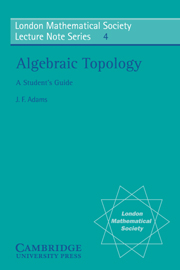Book contents
- Frontmatter
- Contents
- INTRODUCTION
- PAPERS ON ALGEBRAIC TOPOLOGY
- 1 Combinatorial homotopy
- 2 An axiomatic approach to homology theory
- 3 La suite spectrale. 1: Construction générale
- 4 Exact couples in algebraic topology
- 5 The cohomology of classifying spaces of H-spaces
- 6 Cohomologie modulo 2 des complexes d'Eilenberg-MacLane
- 7 On the triad connectivity theorem
- 8 On the Freudenthal theorems
- 9 The suspension triad of a sphere
- 10 On the construction FK
- 11 On Chern characters and the structure of the unitary group
- 12 Espaces fibrés et groupes d'homotopie. I, II
- 13 Generalised homology and cohomology theories
- 14 Relations between ordinary and extraordinary homology
- 15 On axiomatic homology theory
- 16 Characters and cohomology of finite groups
- 17 Extract from thesis
- 18 Relations between cohomology theories
- 19 Vector bundles and homogeneous spaces
- 20 Lectures on K-theory
- 21 Vector fields on spheres
- 22 On the groups J(X). IV
- 23 Summary on complex cobordism
24 - New ideas in algebraic topology
Published online by Cambridge University Press: 23 May 2010
- Frontmatter
- Contents
- INTRODUCTION
- PAPERS ON ALGEBRAIC TOPOLOGY
- 1 Combinatorial homotopy
- 2 An axiomatic approach to homology theory
- 3 La suite spectrale. 1: Construction générale
- 4 Exact couples in algebraic topology
- 5 The cohomology of classifying spaces of H-spaces
- 6 Cohomologie modulo 2 des complexes d'Eilenberg-MacLane
- 7 On the triad connectivity theorem
- 8 On the Freudenthal theorems
- 9 The suspension triad of a sphere
- 10 On the construction FK
- 11 On Chern characters and the structure of the unitary group
- 12 Espaces fibrés et groupes d'homotopie. I, II
- 13 Generalised homology and cohomology theories
- 14 Relations between ordinary and extraordinary homology
- 15 On axiomatic homology theory
- 16 Characters and cohomology of finite groups
- 17 Extract from thesis
- 18 Relations between cohomology theories
- 19 Vector bundles and homogeneous spaces
- 20 Lectures on K-theory
- 21 Vector fields on spheres
- 22 On the groups J(X). IV
- 23 Summary on complex cobordism
Summary
The final piece is an excellent survey article by Novikov. As with many other survey articles, the reader's first object in reading it should be to gain a general understanding of what is going on rather than a grasp of the technical details behind each sentence.
Introduction
In recent years there has been a widespread development in topology of the so-called generalized homology theories. Of these perhaps the most striking are K-theory and the bordism and cobordism theories. The term homology theory is used here, because these objects, often very different in their geometric meaning, share many of the properties of ordinary homology and cohomology, the analogy being extremely useful in solving concrete problems. The K-functor, which arose in algebraic geometry in the well-known work of Grothendieck, has been successfully applied by Atiyah and Hirzebruch to differential topology and has led quickly to the solution of a number of delicate problems.
Among the results obtained strictly with the help of K-theory the work of Atiyah and Singer on the problem of the index of elliptic operators and of Adams on vector fields on spheres and the Whitehead J-homomorphism are outstanding. More or less influenced by the K-functor other functors have appeared, with importance for topology – the J-functor, bordism theories and Milnor's microbundle k-functor. These have thrown new light on old results and have led to some new ones.
- Type
- Chapter
- Information
- Algebraic TopologyA Student's Guide, pp. 274 - 300Publisher: Cambridge University PressPrint publication year: 1972



